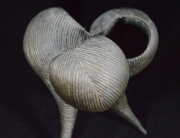Taking a DNA test is a new craze. I heard about it, but I wasn’t really keen on taking the test until Riti, our daughter who herself had taken it, asked me to do so. As she knows me so well, she was well aware that I wouldn’t spend $200 on a kit that requires me to spit—so she signed me up secretly and had the kit shipped to me. So you see, I was forced to take it. My results are back and I am, needless to say, surprised at the findings. I have come to know the DNA compositions of my ancestors—their origins and their ethnic mapping.
With this information, it’s evident that there is nothing truly pure; there is no pedigree when it comes to humans. I’ve always felt affinities with all people, not necessarily biologically. But my belief has been affirmed. Ever since taking the test just last month, I’ve received messages from a variety of individuals claiming to be my 3rd or 4th cousins. It’s comforting indeed that I have distant relatives around the world. If this is not vasudaiva kutumbakam, what is?
Vasudaiva kutumbakam is a Sanskrit phrase found in the Maha Upanishad, a Hindu scripture of Vedic origin. It literally means that the whole world is a family. So you see, even without taking the DNA test, Hindu sages many thousands of years ago knew the truth—that everyone was closely or distantly related with each other biologically.
Jews and Christians, on the other hand, would say that Eve was our mother. Whatever faith traditions we believe in, science says that we had one origin, from which we multiplied and cohabited with one another, resulting in vasudaiva kutumbakam.
As I mentioned, taking a DNA test has become quite popular among the younger generation. There are several DNA testing companies, but among the most popular is 23andMe. Many young professional Nepalis seem to be interested in finding their ancestors and have taken the DNA test with 23andMe.
There are at least three theories regarding the origin of humans on the table— two are religion-based and one is science-based. Of the science-based, Out of Africa is a central belief that suggests human beings originated in Africa with the woman named Lucy, and then spread to the rest of the world. In this theory, Lucy is our original progenitress. Based on archeological findings, Indian scientists have recently advanced the “Out of India” theory. Whichever theory wins, or in whichever theory we believe, the truth of the matter is that we all are connected.
I remember visiting the palace of Ottoman Sultan in Istanbul, Turkey with my family seven years ago. We went to the quarters of the concubines, where more than 500 beautiful women from all over the world were kept for the pleasure of the Sultan. I wouldn’t be surprised if there were a few from Nepal.
The Netflix miniseries Marco Polo depicted young girls in Kublai Khan’s harem speaking in the Nepali language. Again, I wouldn’t be surprised if there were indeed Nepali girls in Kublai Khan’s harem, given the close relationship Nepal and China had during the 13th century.
Given the cross-fertilization between cultures and nations, there was much more fluidity during ancient times than we might think. Carrying genetic traces of many ethnic groups among us, we are truly global citizens.











Leave A Comment